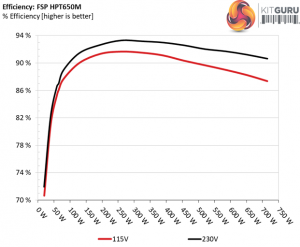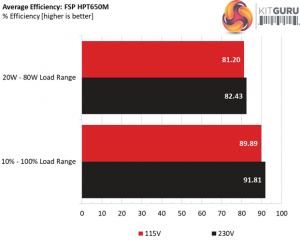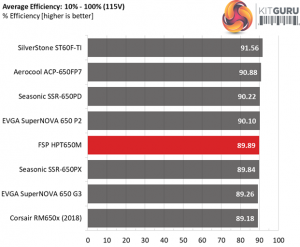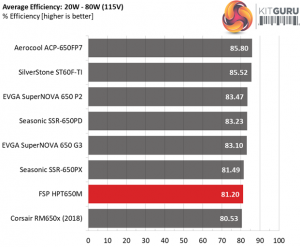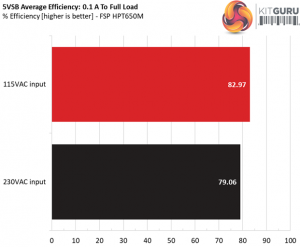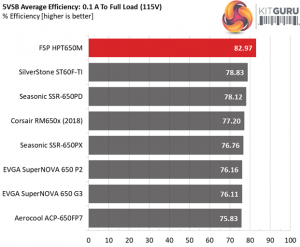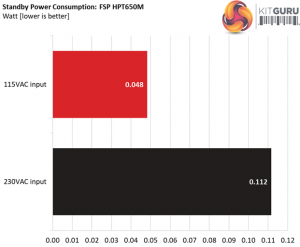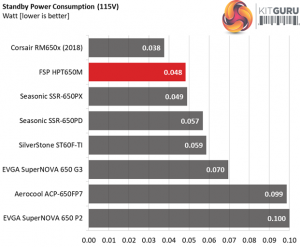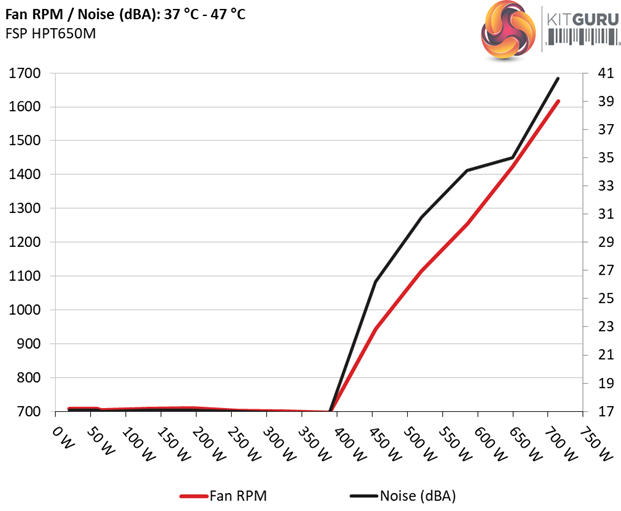Efficiency
Our efficiency testing procedure is detailed here.
Using results from the previous page, we plotted a chart showing the HPT650M’s efficiency at low loads, and loads from 10 to 110 percent of its maximum-rated capacity.
The efficiency with normal loads is high, following closely the Leadex and Prime Platinum platforms. Under light loads FSP's offer has decent performance, however it has a hard time catching up with the competition. Even the 80 PLUS Gold rated, EVGA 650 G3 is ahead of it.
Efficiency At Low Loads
In the following tests, we measure the HPT650M's efficiency at loads significantly lower than 10 percent of its maximum capacity (the lowest load the 80 PLUS standard measures). The loads we dial are 20, 40, 60, and 80W. This is important for representing when a PC is idle, with power-saving features turned on.
| Test # | 12V | 5V | 3.3V | 5VSB | DC/AC (Watts) | Efficiency | Fan Speed (RPM) | PSU Noise (dB[A]) | PF/AC Volts |
| 1 | 1.194A | 0.492A | 0.472A | 0.197A | 19.524 | 70.642% | 708 | 17.1 | 0.697 |
| 12.083V | 5.089V | 3.377V | 5.068V | 27.638 | 115.05V | ||||
| 2 | 2.454A | 0.983A | 0.976A | 0.396A | 39.938 | 81.132% | 708 | 17.1 | 0.773 |
| 12.080V | 5.086V | 3.373V | 5.058V | 49.226 | 115.05V | ||||
| 3 | 3.644A | 1.476A | 1.452A | 5.042A | 59.431 | 85.371% | 708 | 17.1 | 0.831 |
| 12.085V | 5.082V | 3.370V | 5.042V | 69.615 | 115.05V | ||||
| 4 | 4.904A | 1.969A | 1.958A | 0.795A | 79.842 | 87.666% | 705 | 17.0 | 0.882 |
| 12.081V | 5.079V | 3.367V | 5.035V | 91.075 | 115.05V |
We would like to see higher efficiency in the first test. In the rest tests the unit passes the 80% mark. During the entire light load testing procedure the fan spins at a very low speed, producing equally low noise, which most likely most users won't even notice.
5VSB Efficiency
The ATX specification (revision 1.4), along with CEC, ErP Lot 3 2014 and ErP Lot 6 2010/2013, states that the 5VSB standby supply efficiency should be as high as possible, recommending 75 percent or higher with 550mA, 1A, and 1.5A of load.
The supply should also achieve higher than 75% efficiency at 5VSB under full load, or with 3A if its max current output on this rail is higher than 3A.
We take six measurements: one each at 100, 250, 550, 1000, and 1500mA, and one with the full load the 5VSB rail can handle.
| Test # | 5VSB | DC/AC (Watts) |
Efficiency | PF/AC Volts |
| 1 | 0.100A | 0.508 | 79.749% | 0.052 |
| 5.079V | 0.637 | 115.06V | ||
| 2 | 0.250A | 1.269 | 83.377% | 0.207 |
| 5.075V | 1.522 | 115.06V | ||
| 3 | 0.550A | 2.782 | 84.559% | 0.321 |
| 5.058V | 3.290 | 115.06V | ||
| 4 | 1.000A | 5.045 | 85.162% | 0.393 |
| 5.044V | 5.924 | 115.06V | ||
| 5 | 1.500A | 7.548 | 84.213% | 0.434 |
| 5.031V | 8.963 | 115.06V | ||
| 6 | 2.500A | 12.482 | 83.598% | 0.473 |
| 4.993V | 14.931 | 115.06V |
FSP is known for its highly efficient 5VSB circuits. The moment other manufacturers don't care so much about this rail, FSP's engineers strive to provide the best possible 5VSB efficiency and the results are just great! This unit has one of the most efficient 5VSB rail's that we have ever encountered.
Power Consumption In Idle And Standby
In the table below, you’ll find the power consumption and voltage values of all rails (except -12V) when the PSU is idle (powered on, but without any load on its rails), and the power consumption when the unit is in standby mode (without any load, at 5VSB).
| Mode | 12V | 5V | 3.3V | 5VSB | Watts | PF/AC Volts |
| Idle | 12.170V | 5.091V | 3.377V | 5.081V | 7.376 | 0.505 |
| 115.1V | ||||||
| Standby | 0.048 | 0.052 | ||||
| 115.1V | ||||||
The vampire power levels with 115V are very low, however this is not the case with 230V where the power consumption at standby is a little above the average.
Fan RPM, Delta Temperature, And Output Noise
Our mixed noise testing is described in detail here.
The first chart below illustrates the cooling fan's speed (in RPM), and the delta between input and output temperature. The results were obtained at 37°C (98.6°F) to 47°C (116.6°F) ambient temperature.
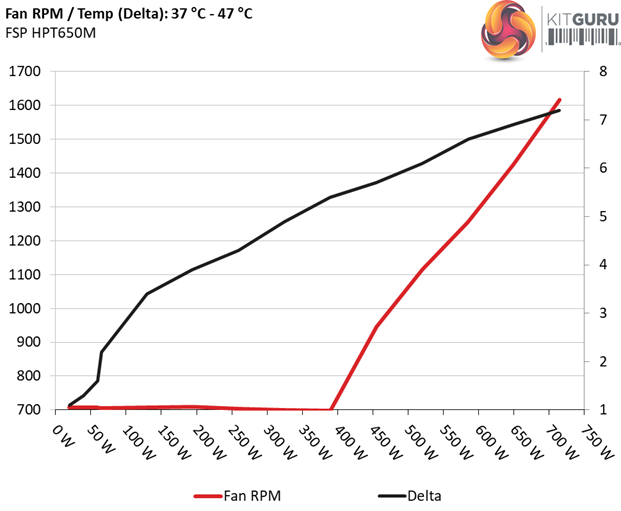
The next chart shows the cooling fan's speed (again, in RPM) and output noise. We measure acoustics from one meter away, inside a hemi-anechoic chamber. Background noise inside the chamber is below 6 dB(A) during testing (it's actually much lower, but our sound meter microphone hits its floor), and the results are obtained with the PSU operating at 37°C (98.6°F) to 47°C (116.6°F)
ambient temperature.
The following graph illustrates the fan's output noise over the PSU's operating range. The same conditions of the above graph apply to our measurements, though the ambient temperature is between 30°C (86°F) to 32°C (89.6°F).
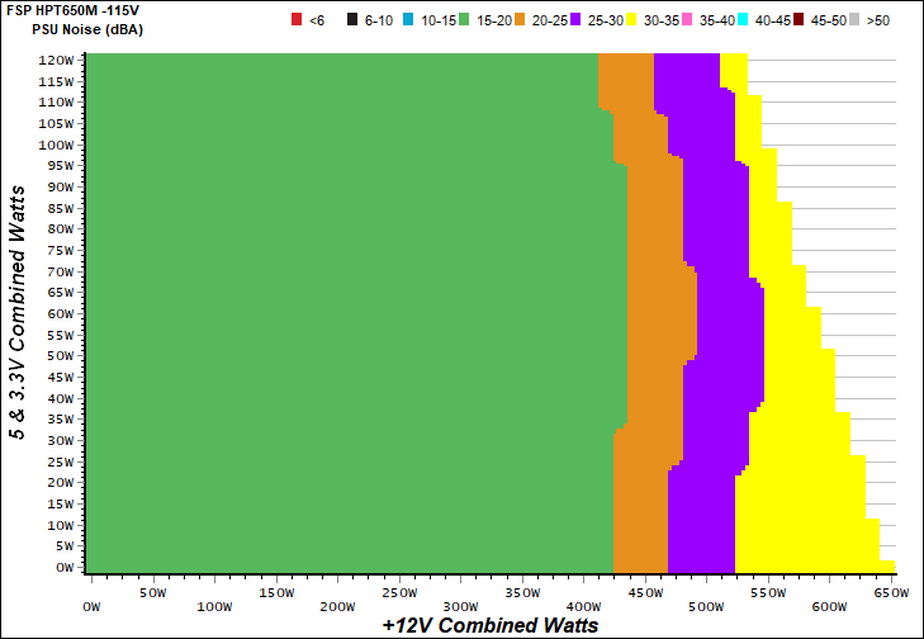
As we already stated, the fan profile is super relaxed. With a so low minimum fan speed there is no need for a semi-passive operation.
The unit enters the 30-35 dB(A) zone only once the load goes higher than 530W, while the ambient is between 30-32°C.
Be sure to check out our sponsors store EKWB here
 KitGuru KitGuru.net – Tech News | Hardware News | Hardware Reviews | IOS | Mobile | Gaming | Graphics Cards
KitGuru KitGuru.net – Tech News | Hardware News | Hardware Reviews | IOS | Mobile | Gaming | Graphics Cards


